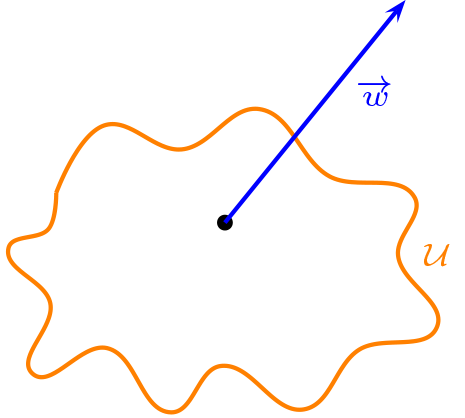Teorema 4.6.1
Si \(f\) es una forma lineal no nula sobre el espacio afín \((V,X)\text{,}\) entonces
es un hiperplano.
Sea \((V,X,\cdot)\) un espacio afín y \(f:V\rightarrow \mathbb{K}\text{,}\) entonces \(f\) es una forma lineal (\(f\) transformación lineal) si y sólo si
Determine si las siguientes funciones son formas lineales
Si \(f\) es una forma lineal no nula sobre el espacio afín \((V,X)\text{,}\) entonces
es un hiperplano.
Como \(f\) es no nula, entonces existe \(\alpha \in \mathbb{K}^*\) y \(\overrightarrow{v} \in V\) tales que \(f(\overrightarrow{v})=\alpha\text{.}\)
Despejando y operando obtenemos que
todo elemento tiene preimagen, es decir
\(f\) es epiyectivaPor teorema de algebra lineal, tenemos la siguiente igualdad
Supongamos \(\text{dim } V=n\) y como \(f\) es epiyectiva, entonces \(\text{dim }(\text{Im }f)=1\text{,}\) entonces
Sea \(\mathcal{U}\leq V\) y \(\mathcal{U}\) hiperplano, entonces existe una forma lineal \(f\text{,}\) tal que \(\text{ker }f =\mathcal{U}\text{.}\)
Si \(\text{dim }V=n\text{,}\) entonces \(\text{dim } \mathcal{U}=n-1\text{.}\)
Sea \(B=\{ \overrightarrow{v_1},\overrightarrow{v_2},\ldots,\overrightarrow{v_{n-1}}\}\) base de \(\mathcal{U}\)
Sea \(\overrightarrow{w}\in V \text{ tal que } \overrightarrow{w}\not \in \mathcal{U}\text{,}\) entonces \(V=\mathcal{U} + \left\langle \overrightarrow{w}\right \rangle\)

Sea \(\overrightarrow{v} \in V\text{,}\) entonces existen únicos \(\overrightarrow{u}\in \mathcal{U}\) y \(\alpha \in \mathbb{K}\) tales que
Por lo anterior, se obtiene la función
que claramente es una forma lineal y \(\text{ker }f = \mathcal{U}\text{.}\)
El teorema anterior, nos permite determinar la ecuación cartesiana de un hiperplano vectorial.
Sea \(B'=\{\overrightarrow{w_1},\overrightarrow{w_2},\ldots, \overrightarrow{w_{n}} \}\) otra base de \(V\) y con las notaciones anteriores, si \(\overrightarrow{v}\in \text{ker }f \) entonces
luego
esta última, es la forma general de la ecuación cartesiana de un hiperplano vectorial con respecto a la base \(B'\text{,}\) es decir,